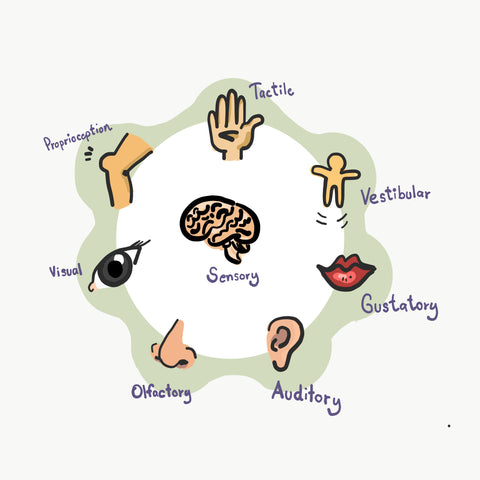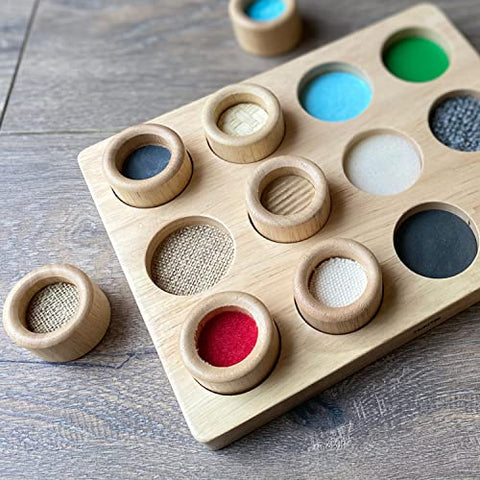
Sensory Surroundings is supported by its audiance. When you purchase through links on our site, we may earn an affiliate commission. Learn more
Have you ever wondered how sensory play can shape your child’s development? Engaging in sensory play isn’t just fun – it’s a gateway to building vital cognitive, motor, and social skills. From better problem-solving to more articulate communication, the benefits of sensory play are extensive.
Let’s take a look at the many benefits that sensory play has to offer children, helping you understand why playtime is more than mere entertainment.
Unlocking the Advantages of Sensory Play
Sensory play is a non-traditional method of learning that uses all five commonly known senses - sight, hearing, touch, smell, and taste. Many activities also engage the lesser-known senses of vestibular, proprioceptive and interoception. Yes, there are eight senses in total!
This approach allows children to explore and naturally make sense of the world around them, thus creating stronger connections in their brains.
Sensory play activities contribute to overall cognitive development and enhance a child’s perception of their surroundings. Sensory play includes activities such as:
- Playing with sand or water
- Finger painting
- Exploring different textures with hands or feet
- Listening to different sounds or music
- Tasting different foods or flavours
These activities help children engage by involving multiple senses, providing a rich learning experience for them. Sensory play is also instrumental in developing problem-solving skills as it encourages children to:
- observe
- hypothesise
- experiment
- conclude
It also aids language development by teaching children descriptive words as they use different textures and materials. You can use this opportunity to talk to them about what they’re experiencing and describe how things feel.

Boosting Brain Development
Sensory play bolsters the development of the brain’s neural pathways, which is a vital aspect of a child’s ability to engage in complex learning tasks and contributes to a child’s development. These nerve connections play a crucial role in enhancing memory, an essential part of learning and executing intricate tasks and problem-solving.
Children’s memory and observational skills are strengthened through sensory play, fostering both creative and independent thinking. Simultaneously, sensory play aids in the development of memory function, which is integral for the learning and retention of new knowledge.
As previously mentioned, this form of play also fosters language skills, including vocabulary expansion and phrase building. This aids children in comprehending age-relevant concepts. As children describe their experiences and communicate their emotions during sensory play, they are simultaneously enhancing their language abilities.
Developing Motor Skills
Sensory play activities, such as manipulating playdough and writing in kinetic sand, help develop children’s fine motor skills that are necessary for everyday tasks like holding a pen or using scissors. Sensory play also fosters gross motor skills, involving the large muscles used in walking, jumping, and throwing, through activities like running and playing musical instruments.
Incorporating sensory bins such as water pouring stations into play and providing toddlers with appropriate tools in these activities can promote both fine and gross motor skills through practical life skills practice.
Sensory Activities for Different Ages
Sensory play activities can be tailored to suit the developmental stages of babies, toddlers, and preschoolers, promoting exploration, and learning. Activities like finger painting offer open-ended sensory exploration, stimulating multiple senses in children.
Sensory play can be crafted using diverse resources or simple materials such as:
- ice and water to create distinctive sensory experiences for children
- musical instruments to enhance their early educational experiences
- kinetic sand to engage their senses
Tactile Play for Infants
Tactile play encompasses sensory activities that engage an infant’s sense of touch, vital for their early development. Introducing different textures to infants, such as using chiffon or textured toys, fosters tactile exploration and sensory development.
Activities such as mess-free painting, which involves squishing paint inside a sealable bag, provides a tactile experience without the mess, suitable for infants. Participation in tactile sensory play assists with the refinement of fine motor skills, crucial for future tasks like writing.

Engaging Toddlers with Sensory Bins
Introducing sensory bins to toddlers should prioritise the use of materials that are taste-safe and do not pose a choking hazard. Some examples of safe materials include:
- Dry rice
- Water
- Cornmeal
- Dyed tapioca pearls (a safer alternative to traditional water beads)
These materials provide a fun and safe tactile experience for mouthing toddlers.
Other ideal fillers for sensory bins include jelly, dry oatmeal, and dyed noodles, which offer a variety of textures while being safe for toddlers to explore with their mouths.
Another idea is to create an edible cereal safari sensory bin that can stimulate sensory exploration for toddlers through different cereal textures and shapes, also aiding picky eaters.
Stimulating Preschoolers through Musical Instruments and Kinetic Sand
Kinetic sand can be used to create a racetrack for toy cars and trucks, stimulating preschoolers’ imagination and aiding the development of storytelling skills. A zen garden made of kinetic sand provides a calming sensory experience for preschoolers, promoting mindfulness and the ability to concentrate.
Homemade shakers as part of a musical sensory play allow preschoolers to explore sounds with different filling materials, facilitating an understanding of audio sensations and cause and effect. Sensory activities centred around themes can be created to immerse children in a rich linguistic context, bolstering their problem-solving skills and creativity.
Fostering Social and Emotional Growth through Sensory Play
Sensory play is vital for fostering social interactions among children, encouraging them to navigate shared experiences and adapt to the different playing styles of peers. This form of play not only enhances cognitive and motor skills but also plays a significant role in developing social skills and emotional well-being, making sensory play important.
Through shared sensory play activities, children learn how to cooperate, share, and resolve conflicts effectively. They also get to practice emotional development and awareness, which are key components of social skills. These social skills for children are made up of:
- Play skills - such as taking turns and sharing
- Conversation skills - including topic choice and body language
- Emotional skills - recognising and managing emotions and understanding how others feel
- Problem-solving skills - including conflict resolution and decision making
Promoting Social Skills
Group sensory activities like playing with building blocks or on swings provide a platform for children to learn cooperation, sharing, and ways to resolve conflicts effectively. Sensory play supports critical aspects of communication and language development, which are essential for meaningful social interactions among children.
Experiencing sensory activities in a group setting enables children to practice emotional development and awareness, which are key components of social skills.
Supporting Emotional Well-being
Sensory play provides a calming influence that can mitigate feelings of anger or anxiety in children. The calming effect of sensory play creates a supportive environment for engaging in problem-solving and creative tasks.
Through tactile play and other sensory experiences, children can physically express their emotions, aiding in emotional expression. Sensory play activities are instrumental in helping children learn self-regulation, an essential skill for emotional well-being.

Adapting Sensory Play for Home and Classroom Environments
Sensory play can be adapted for home and educational settings to support children’s sensory sensitivities and learning experiences. This involves using household items and dedicated sensory spaces.
Implementing cost-effective sensory solutions at home can involve:
- Using chewies
- Using sour spray
- Creating makeshift swings
- Creating crash pads
- Introducing auditory aids like noise-cancelling headphones
Classroom strategies to support sensory play include creating sensory diets tailored for individual needs, incorporating heavy work like chair press-ups and other sensory circuit activities. It’s also a good idea to establish calming spaces such as sensory rooms.
Utilising Household Items for Sensory Exploration
Common household materials like water, sand, and various textures can be used for sensory play activities. Here are some other options you can try at home:
- Sensory bottles filled with colourful water beads and baby oil can be a mesmerising tactile play item for infants to explore.
- Shaving cream can be spread on a plate or baking sheet to allow children to draw and write in the foam, and adding glitter or coarse salt can vary the textural experience.
- Dried rice or beans from the pantry can be used in sound shakers, weighted bean bags, or sensory bins for tactile and auditory exploration.

Creating Sensory Spaces in Educational Settings
Sensory play helps children with autism to engage with their environment and develop cognitively, making it an essential component in classroom design. Sensory tables can be incorporated into classroom settings as a dedicated space for children to explore and learn through tactile experiences.
Themed sensory bins can be created to match educational topics or seasons, providing focused sensory experiences and learning opportunities. Additional sensory elements like water play areas, tactile wall panels, and interactive floor tiles can further enrich the sensory spaces in educational settings.
Summary
In conclusion, sensory play is a powerful tool that offers numerous benefits spanning from cognitive growth to social and emotional development. By engaging all the senses, it aids in enhancing brain development, motor skills, problem-solving abilities, and creativity.
Moreover, sensory play allows for age-appropriate activities, fostering exploration and learning at every stage. It also promotes social interactions and emotional well-being. Importantly, sensory play can be adapted for home and educational environments, supporting children’s sensory sensitivities and enriching their learning experiences.
Frequently Asked Questions
How does sensory play help emotional development?
Sensory play helps emotional development by allowing children to explore the world through their senses, promoting creative thinking and providing a therapeutic outlet for emotions when verbal expression is challenging.
Why is sensory play important for disabilities?
Sensory play is important for disabilities because it strengthens neural pathways and lays strong foundations for learning in the future. It helps individuals with disabilities to better understand the world around them and improve their overall development.
What are the learning outcomes of sensory play?
Sensory play supports brain development, enhances memory, and fosters fine motor skills, language development, and social skills in children. This type of play also helps with complex tasks and problem-solving.
What are some simple sensory play activities I can try at home?
You can try sensory play activities at home using common household materials like water, sand, and textures, or by creating sensory bottles. Have fun exploring some of the many simple activities we highlight in our articles.
What are sensory bins and how can they be used?
Sensory bins are containers filled with materials that stimulate the senses, such as dry rice or water for toddlers and themed educational items for preschoolers. They can be used to promote sensory exploration and learning.
We’d love to hear what you think about the benefits of sensory play for children. If you have a good activity or a question, please share it by leaving a comment below.
To stay up to date with more great ideas, activities and information for your children, you can subscribe to our newsletter and follow us on social media!
References:
- Environment-Behaviour Proceedings Journal. Significance of Sensory Activities among Toddlers for Sensory Skills Development (2021).
- Sense: Tips for music-making with children with sensory impairments and complex disabilities (2022).




